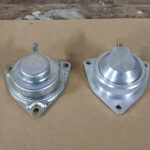Are Automatic Cars Good for Hills? Are Manuals Better?
Alfred Horner Munro is regarded as the pioneer of modern-day automatic cars. The Canadian steam engineer patented his design of automatic transmission in 1921. This transmission was a lot simpler than what we have today. It had no reverse and parking gears.
Since its invention, automatic cars have been praised and criticized alike by car experts. It carries certain advantages and disadvantages over manual transmission. In this article, we will discuss whether automatic cars are good for hills or not.

Are Automatic Cars Good for Hills?
In the past, automatic cars were not considered good vehicles for hills. But with newer technologies arriving in the market every day, things have changed considerably. Now, cars with automatic transmission offer more or less similar performance to manual cars in hilly areas. TSI and DSG variants of automatic vehicles are even better in this regard.
It was a common myth in previous days that manual vehicles exhibit superior performance on hilly and mountainous terrain. It was considered so because automatic vehicles tend to show a slower response. When the main control power lies with the system computer or ECU then the maneuverability of the vehicle is somewhat compromised.
Why are automatic cars good for hills now is due to the arrival of cutting-edge technology like direct shift gearbox (DSG). The sensors and computers have also improved a great deal. Now gear shifting process in auto cars is a lot more subtle and smooth. Hence, the core issue of sudden gear shifts is resolved.
Also read: Do Automatic Cars Use More Fuel? (Comparison)
What Make Automatic Cars Difficult for Hills?
The following reasons make it very difficult for automatic cars to give a decent performance in hilly areas:
- Delayed response of the automatic transmission
- The driver has no control without a gear stick and clutch
- Inability to make sudden gear shifts
- High breakdown ratio of automatic cars in hills
- You have to worry about sensors and warnings
- Delayed Response: The main reason why automatic cars suck in hills is due to their delayed response. When a slope is detected by the automatic car, then the rpm at the output of the engine shaft are reduced and torque is multiplied.
As a result, more power is available for climbing the hill. In automatic cars, this whole closed-loop process takes time. Hence, often a delayed response is noticed. In which it becomes difficult for the car to climb up the mountains.
- The driver has no Control: In automatic cars, more reliance is on the brains of the car, the ECU. However, when roads are twisted and unevenly slopped, then it is crucial to have decision power with the driver. So he can make sudden adjustments to ensure a smooth ride.
- Inability to Make Sudden Gear Shifts: Automatic cars follow due process, as they don’t jump from one gear to another. Rather, shifting of gear takes place one by one. But what if you have to shift from 4th to 1st gear immediately.
Trending Video: How to Easily Bring Back to Life any Old Car Battery and Save Tons of Money (click to watch)
The auto car will go from 4th to 3rd then from 3rd to 2nd and then from 2nd to 1st gear. This will lose time and affect the ability of the car to climb up the hill.
- High Breakdown Ratio: Driving in hilly areas can cause extra wear to your car. Under normal circumstances, automatic cars are more prone to breakdown as they have a higher number of moving parts. So, in these stressed conditions, the chances of failure are even higher. This makes auto cars difficult for hills.
Are Manual Cars Better for Hills?
If we consider driving in hills only, then yes, manual cars might have certain advantages over automatics. Take all the reasons that make it difficult for automatic cars to be driven in hills. Reverse those reasons, and that’s exactly why manual cars are better for hills.
The core reason why manual cars are better for hills is due to the fact that in these vehicles, the decision power lies with the driver. So, whenever there is a sudden change in slope, he can adjust the gear accordingly.
The same reason brings forth another advantage of maneuverability. The slow response of automatic cars makes it near to impossible for them to be driven in mountains. But with control in the hands and feet of the driver, this no more remains an issue.
Still, if you are confused, then the following are some other reasons why it is a good idea to choose a manual car for hills:
- Manual transmissions are more efficient.
- Fuel mileage is a big issue in hilly areas. With manual cars, you get better mileage, and you can save a lot of fuel.
- Manual transmission requires lesser maintenance due to the lesser number of moving parts.
- Manual cars have better speed and power control as compared to automatic ones.
Also read: 5 Reasons Why Europeans Hate Automatic Transmission
What Should Your Automatic Car Have to be Good for Hills?
Avoid using automatic cars with continuously variable transmission (CVT) for hills. Your car should have a powerful engine paired with an all-wheel-drive powertrain for hills. Smart features like hill hold are also very useful in this regard. In addition to that, your automatic car must have sufficient cornering stability and road grip.
- Hill Start Assist
The hill-start assist feature makes it impossible for a car to go backwards while driving uphill. The biggest problem manual transmission drivers face on hills is their car moving backward every time they resume their journey from still position. Hence, this feature in automatic cars comes in pretty handy.
- Hill Descent Assist
Hill descent assist aids your car while you are coming down from the hills. By enabling this feature, you don’t have to worry about braking on your way down the slope. This function automatically applies brakes to the engine output shaft. This eliminates the possibility of brake meltdown, making your rides safer and smoother.
- All-Wheel Drive
An all-wheel drivetrain is an ideal feature to have in an automatic car if you are intending to use it in hilly areas. In an all-wheel-drive car, engine power is evenly distributed between all wheels. This offers better road grip and steady acceleration. It also provides a much-needed boost to climb up the hills.
- Powerful Engine
When you have to fight treacherous slopes, then it can never hurt to have a powerful engine. All cars designed for hills have high-power outputs. Because no matter the fancy features in your car, nothing can substitute a good old-fashioned engine blowing out heaps of power. Cars with powerful engines are ideal candidates for hill driving.
- Accurate Steering & Traction Control
Hilly roads usually stand for steep and twisted terrain. To maintain balance and stability on such roads, your car must have sufficient cornering stability and road traction. Both wet and dry road traction is important for hilly roads. Though it has more to do with tires, still the suspension of the car has a vital role in ensuring traction.
- TSI, DSG, and Torque Converter
Turbocharged Stratified Injected (TSI) engine is an innovation by Volkswagen. This engine has a very high torque output at lower RPMs. So, a car with this technology can perform way better in hilly areas.
Similarly, DSG or direct shift gearbox is another great feature to have in your car engine. It enables smooth and rapid gear shifting. Which makes the car more responsive, enabling it to shift between gears efficiently, when inclined roads are encountered.
Automatic cars with TSI, DSG, and torque converter technology are equally viable for hills. However, you must avoid continuous variable transmission (CVT) cars at all costs if you are going to drive in hills.
The infinite speed combination available in CVT makes it impossible for your car to find a suitable configuration. Where toque and rpm can be optimized. Hence, CVT cars perform poorly in hilly areas.
Also read: 10 Horrible Disadvantages of Automatic Cars
How to Drive an Automatic Car in Hills?
Automatic cars can give off an extremely decent performance in the hills if you follow some simple rules. The best tips to drive an automatic car in hills are:
- Whenever you are climbing hills, stay in D2 or D3 instead of simple D. Since, D2 and D3 offer higher torque at lower RPMs. This serves the same purpose as a lower gear in manual transmission.
- As soon as you see that the incline on the road is increasing drastically, then push your car to the limits so that you have enough power to tackle the slope.
- While coming downhill, don’t overuse the break and never put your car in neutral mode. This may cause brake failure and compromise your safety.
- Use the hill assist feature to the best advantage. Smart utilization of the hill-hold feature can amplify the hill driving experience of your automatic car.
- Try to keep a lighter foot on the gas pedal to minimize fuel consumption.
What are the Best Automatic Cars for Hills?
My top three picks for the best automatic cars for hills are:
- Toyota 4Runner
- Volkswagen Atlas
- Honda CR-V
- Toyota 4Runner
What makes Toyota 4Runner a top contender for best hills car is its powerful 4-liter V6 engine that is capable of churning out 270 hp. The car also offers smart features like active traction control and a limited-slip differential.
- Volkswagen Atlas
Volkswagen is the pioneer of TSI and DSG engines. Atlas is one car that is equipped with these technologies. This car is also laced with all standard hill start and descent features. Making it a perfect car for hills.
- Honda CR-V
Honda CR-V has great fuel economy, which comes in handy on hills. It offers generous ground clearance, a real-time AWD drivetrain, and a highly stable ride. Honda CR-V has a powerful turbocharged engine capable of dealing with any slopes.
caranddriver.com, statista.com, media.vw.com, team-bhp.com, echopark.com,mycarhelpline.com, wuling.id, kia.com, cartoq.com, quora.com, blog.passmefast.co.uk, drive.govt.nz, autoblog.com






